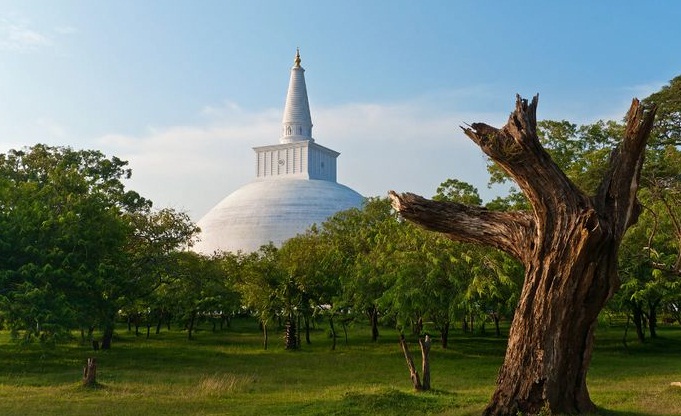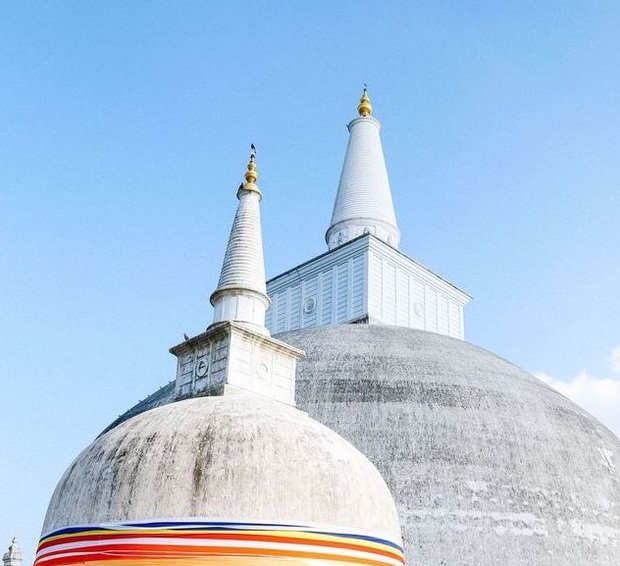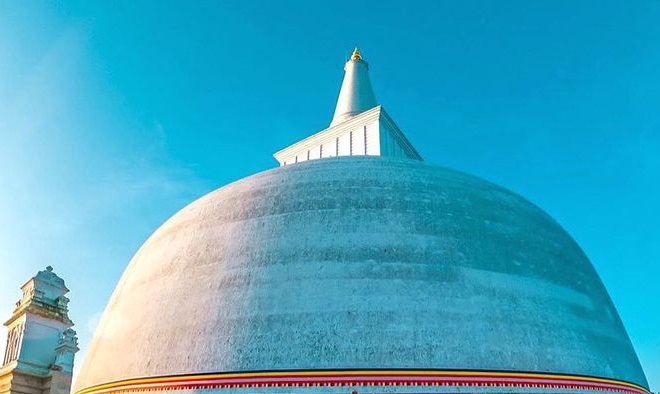
The massive stupa known as Ruwanwelisaya is tucked away in Sri Lanka’s holy city of Anuradhapura and is of great religious, historical, and cultural significance. One of Sri Lanka’s most famous and recognizable buildings, the Great Stupa is a towering landmark that draws pilgrims and visitors from all over the world. In-depth discussions about Ruwanwelisaya’s long history, its founders, its age, and the significance of visiting this holy site are covered in this blog.
Ruwanwelisaya History

The development of Buddhism in Sri Lanka is closely linked to the history of Ruwanwelisaya. King Dutugemunu, a legendary character in Sri Lankan history, ruled from 161 to 137 BCE, and he ordered the construction of the stupa. The island was brought together by King Dutugemunu, who also made Buddhism the predominant religion in Sri Lanka. One of his most important projects was the building of Ruwanwelisaya, which stands for both national unity and the victory of Buddhism.
Originally called the Maha Thupa (Great Stupa), the Ruwanwelisaya was built to house Buddha relics. Construction on the stupa commenced in 140 BCE and was concluded following the demise of King Dutugemunu by his sibling, King Saddhatissa. The building is a reminder of Sri Lanka’s past religious commitment and architectural prowess. Ruwanwelisaya has undergone numerous restorations throughout the ages, but its central structure still serves as a testament to the island’s rich Buddhist past.
Why is Ruwanwelisaya Famous?

Ruwanwelisaya is a must-visit location for everybody interested in Sri Lankan history and culture because of its many renowned attributes. Primarily, it is among the most significant and ancient stupas in Sri Lanka, having functioned as a hub for Buddhist devotion for more than two millennia. The stupa is particularly well known for its enormous size and excellent architectural details, such as its elaborately carved stone borders, vast dome, and elaborate pinnacle.
Ruwanwelisaya’s association with King Dutugemunu, a national hero of Sri Lanka, is another factor in its renown. The stupa is regarded as a representation of his commitment to Buddhism and his initiatives to foster harmony and peace on the island. Ruwanwelisaya is also well-known for the sacred relics housed within, which are said to include the collarbone of the Buddha, some of his ashes, and other priceless artifacts.
The stupa’s significance stems from its participation in a number of religious rituals and celebrations, including Poson Poya, an occasion that marks the arrival of Buddhism in Sri Lanka. Ruwanwelisaya becomes a hub for devotees at these occasions, who congregate to offer prayers and take part in rites.
Who Founded Ruwanwelisaya?

King Dutugemunu, one of the most renowned monarchs in Sri Lankan history, founded Ruwanwelisaya. Dutugemunu was the eldest son of King Kavantissa of the Kingdom of Ruhuna, having been born in the second century BCE. His military battle against Elara, the Tamil monarch who had controlled the Anuradhapura Kingdom for forty-four years, is what made him most famous. Following Elara’s defeat and the island’s unification under his leadership, King Dutugemunu concentrated on advancing Buddhism and erecting sacred structures, the most ambitious of which was Ruwanwelisaya.
Ruwanwelisaya was intended to be a great stupa built by King Dutugemunu that would house priceless Buddha artifacts and act as a symbol of Buddhism in Sri Lanka. Dutugemunu’s desire came true, even though his brother King Saddhatissa did not live to see it through. The stupa is still a visible reminder of the monarch’s vision, devotion, and leadership.
How Old is Ruwanwelisaya?
Ruwanwelisaya is one of the oldest stupas in Sri Lanka and among the oldest religious structures in the entire world, dating back more than 2,000 years. Around 140 BCE, during the reign of King Dutugemunu, work on the structure started, and soon after, King Saddhatissa, his brother, finished it. Because of the numerous restorations made throughout the ages by conservationists and succeeding emperors, Ruwanwelisaya has remained astonishingly intact despite its antiquity.
The lengthy lifespan of the stupa is evidence of the sophisticated engineering and building methods used in prehistoric Sri Lanka. Ruwanwelisaya has endured as a symbol of Sri Lanka’s enduring Buddhist legacy because of the careful craftsmanship and use of sturdy materials like bricks and stone.
Why Go to Ruwanwelisaya?
A fascinating experience that provides a deep connection to Sri Lanka’s spiritual and cultural legacy is a visit to Ruwanwelisaya. The stupa is a living religious site where devotees come to offer prayers, meditate, and seek blessings; it is more than just a historical monument. A trip to Ruwanwelisaya provides Buddhists with a chance to honor the Buddha and consider his teachings. Ruwanwelisaya provides a window into the architectural and engineering skill of ancient Sri Lanka for history buffs and tourists. The stupa is an amazing sight to see because of its enormous size, beautiful carvings, and precious treasures. The surrounding region, with its verdant foliage and peaceful ponds, contributes to the site’s meditative mood.
Moreover, pilgrims go to Ruwanwelisaya on significant Buddhist holidays like Poson Poya and Vesak. Thousands of devotees are present, ceremonies are held, and the stupa is magnificently illuminated during these hours. The neighborhood comes to life. Taking part in these occasions offers a singular perspective on Sri Lanka’s colorful religious customs.
How to Visit Ruwanwelisaya?

Because Ruwanwelisaya is situated inside the UNESCO World Heritage Site of Anuradhapura, the ancient city, visiting it is very simple. Major cities such as Colombo and Kandy can easily be reached by road and train from Anuradhapura. The city offers a variety of lodging choices to suit the needs of various kinds of visitors, from high-end hotels to inexpensive guesthouses.
The stupa is situated in the Sacred City of Anuradhapura, which is a good place to start your exploration of Ruwanwelisaya. The best times to visit are in the early morning or late afternoon when the weather is cooler and the lighting is ideal for taking pictures. The site is open to visitors all year round. Foreign visitors must pay an admission charge in order to see the historic city’s other noteworthy locations.
Since Ruwanwelisaya is a sacred location, it is vital to dress appropriately and modestly when visiting. Before approaching the stupa grounds, visitors must take off their shoes. As a symbol of respect, it is customary to circle the stupa clockwise.
What to See in Ruwanwelisaya?
Ruwanwelisaya offers a wealth of sights and experiences that captivate both the eyes and the soul. Here are some of the key highlights:
- The Great Dome: The most striking feature of Ruwanwelisaya is its massive dome, which dominates the skyline of Anuradhapura. The dome is a perfect hemispherical shape and is topped with a pinnacle adorned with a crystal. The dome is a symbol of the universe, and its sheer size is awe-inspiring.
- The Sandakada Pahana: At the entrance to the stupa, you will find intricately carved stone moonstones, known as Sandakada Pahana. These semi-circular slabs are unique to Sri Lankan architecture and depict various animals and floral motifs, symbolizing the cycle of birth, death, and rebirth.
- The Guard Stones: Gorgeously carved guard stones with representations of gods and mythological animals flank the entryway. These stones are thought to ward off evil spirits and safeguard the stupa.
- The Most Precious Relics: Ruwanwelisaya is purported to contain some of the Buddha’s most revered relics, such as his collarbone and some of his ashes. The presence of these relics enhances the site’s spiritual significance even though they are hidden from view.
- The Outer Courtyard: which encircles the stupa, is frequently crowded with devotees who are praying and meditating. Smaller stupas, shrines, and statues, each having a unique religious and historical significance, can also be seen in the courtyard.
- The Illumination Ceremony: Thousands of oil lamps and electric lights will illuminate the stupa if you visit Ruwanwelisaya during a Buddhist festival. One of the visit’s highlights is this amazing sight, which also generates an incredibly magical mood.
Conclusion
More than just a historical landmark, Ruwanwelisaya in Anuradhapura is a living representation of Sri Lanka’s rich Buddhist past as well as a tribute to the artistry and dedication of the country’s prehistoric inhabitants. Ruwanwelisaya provides an amazing experience regardless of whether you are a pilgrim looking for spiritual consolation or a tourist enthralled with the history and beauty of the area. Its imposing dome, revered artifacts, and tranquil settings make it an essential stop for anybody touring Sri Lanka’s cultural riches.

Leave a Reply